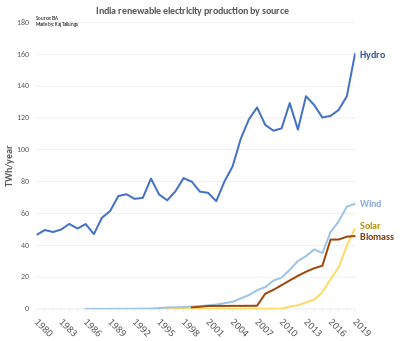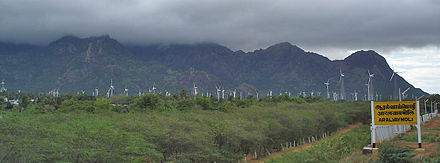What is Electrical Power Generation?
Electricity is generated at power plants and transmitted to different substations from where it will be distributed to individual customers.
Importance of Electrical Energy
Electrical energy is the most popular form of energy, whether we require it in the usable formslike;
- in thermal form ( heating applications)
- in mechanical form (electrical motor applications in Industries)
- for lighting purposes ( illumination systems)
- or for transportation systems.
Reference Notes
1.General layout of Steam Power Station|Steam power plant parts
2. Steam power plants|Steam power generator Plant|Thermal Power stations
3. Rankine cycle|power Cycle for steam power plants
4. Parts of a Power transmission line and Transmission tower|Transmission tower parts
Why is Electrical Energy Preferred?
- Cleaner environments for user
- Higher efficiency
- Better controllability
- Easier bulk-power, long-distance transportation of power using overhead transmission or
underground cables - Most versatile devices of energy conversions from Electrical to other forms are available for
different purposes, such as thermal, illumination, mechanical, sound, chemical, etc.
Sources for Generation of Electricity
Conventional methods
(a) Thermal energy
Thermal energy (from fossil fuels) or Nuclear Energy used for producing steam
for turbines which drive the alternators (= rotating a.c. generators).
(b) Hydro-electric energy
The potential energy of water stored at higher altitudes is utilized as it is passed through
water turbines which drive the alternators.
Non-conventional methods
/

(c) Wind power
High velocities of wind (in some areas) are utilized in driving wind turbines
coupled to alternators. Wind power has the main advantage of having zero production cost.
The cost of the equipment and the limit of generating-unit-rating is suitable for a particular
location (= geographically) are the important constraints.
advantages of Wind energy
- pollution free and renewable.
- It is available in plentiful quantity, at certain places.
disadvantages of Wind energy
- its availability being uncertain (since dependent on nature) and
- the control being complex (since wind-velocity has wide range of variation, as an input, and the output required is at constant voltage and constant frequency).
- Single large-power units cannot be planned due to techno-economic considerations.
(d) Fuel cells energy
These are devices which enable direct conversion of energy, chemically, into electrical
form.
This is an upcoming technology and has the special merit of being pollution-free and
noise-free. It is yet to become popular for bulk-power generation.
(e) Photo voltaic cells energy
These directly convert solar energy into electrical energy through a chemical action taking place in solar cells.
These operate based on the photovoltaic effect, which develops an emf on the absorption of ionizing radiation from the Sun.
Power Scenario In India
The following approximate statistical data gives an idea about some aspects in this regard.
The break up of renewable energy sources (RES) is:
Solar power (57,973.78 MW)
Wind power (40,893.33 MW)
Biomass/Cogeneration (10,205.61 MW)
Small hydro (4,887.90 MW)
Waste-to-energy (476.75 MW)
Classifications of Power Transmission
(a) Using underground cables or using overhead transmission lines.
(b) Extra High Voltage A.C.-versus-Extra High Voltage D.C. transmission systems.
Selecting A.C. Transmission Voltage
In general, for transporting a given power of V I watts, either V can be high or V can be low.
Accordingly, the current can be either low or high respectively. Higher voltage means higher cost of
insulation, and larger clearances. Higher current means larger cross section of conductors.
Considering these together, the most economical voltage has to be found out for a particular requirement.
Kelvin’s Laws give a guideline for this.
Kelvin’s Laws
Note:
Nuclear power is the fifth-largest source of electricity in India after thermal, hydroelectric and renewable sources of electricity.
Thermal power is the “largest” source of power in India.
There are different types of thermal power plants based on the fuel that are used to generate the steam such as coal, gas, and diesel, natural gas.
About 71% of electricity consumed in India is generated by thermal power plants
Energy policy of India
The energy policy of India is to increase energy in India and reduce energy poverty, with more focus on developing alternative sources of energy, particularly nuclear, solar and wind energy
Energy conservation
Energy conservation has emerged as a major policy objective, and the Energy Conservation Act 2001, was passed by the Indian Parliament in September 2001
This Act requires large energy consumers to adhere to energy consumption norms; new buildings to follow the Energy Conservation Building Code, and appliances to meet energy performance standards and to display energy consumption labels.
The Act also created the Bureau of Energy Efficiency to implement the provisions of the Act.
In 2015, Prime Minister Mr. Modi launched a scheme called Prakash Path urging people to use LED lamps in place of other lamps to drastically cut down lighting power requirements and the evening peak electricity load.
Energy efficient fans at subsidized prices are offered to the electricity consumers by the electricity distribution companies (DisComs) to decrease peak electricity load.
Energy saving certificates (PAT), various renewable purchase obligations (RPO), and renewable energy certificates (REC) are also traded on the power exchanges regularly
Recent amendments to Energy Conservation Act in December 2022 included carbon trading provisions, green fuels mandatory use, etc
Renewable energy in India
India is world’s 3rd largest consumer of electricity and world’s 3rd largest renewable energy producer with 40% of energy capacity installed in the year 2022 (160 GW of 400 GW) coming from renewable sources.
The renewable Energy Country Attractiveness Index (RECAI) ranked India 3rd behind USA and China.
Wind power in India
The development of wind power in India began in the 1990s, and has significantly increased in the last few years.
As of 30 September 2022, the total installed wind power capacity was 41.666 GW, the fourth largest installed wind power capacity in the world.
Wind power capacity is mainly spread across the Southern, Western, and Northwestern states
Wind power accounts for 10% of India’s total installed power capacity.
wind-solar hybrid policy
The Indian Government’s Ministry of New and Renewable Energy announced a new wind-solar hybrid policy in May 2018.
This means that the same piece of land will be used to house both wind farms and solar panels.
Largest wind farms in India
As of 30 June 2018 the installed capacity of wind power in India was 34,293 MW
mainly spread across Tamil Nadu (7,269.50 MW), Maharashtra (4,100.40 MW), Gujarat (3,454.30 MW), Rajasthan (2,784.90 MW), Karnataka (2,318.20 MW), Andhra Pradesh (746.20 MW) and Madhya Pradesh (423.40 MW).

Wind farms in Kerala
55 MW production of wind power is installed in Kerala. The first wind farm of the state was set up in 1997 at Kanjikode in the Palakkad district.
- Environment MCQ for RRB JE CBT 2|Objective Questions Environment for Competitive Exams
- RRB JE CBT 2 Computer Awareness Book Arihant|Objective Computer Awareness Book 2025
- RRB JE CBT 2 Exam Date 2025 Postponed|RRB JE CBT 2 Exam Date
- [PDF]RRB JE Result 03/2024 Cut off, Selected no of candidates for all regions
- [PDF]Final Answer Key Junior Instructor Mechanic Agricultural Machinery|643/2023 Solved Question paper
/
- Latest Syllabus of KSEB Sub Engineer Electrical Exam 2023
- Basic Electrical MCQ Questions
- EEE Made Easy Book Store
- Sub Engineer Study Notes
- Electronics Engineering



